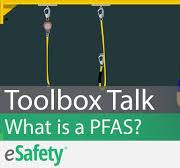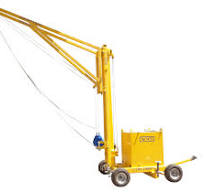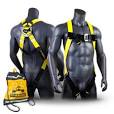The Importance of Personal Fall Arrest Systems in Workplace Safety
Personal fall arrest systems are crucial components of workplace safety, particularly in industries where employees are at risk of falling from heights. These systems are designed to protect workers from serious injury or death in the event of a fall by stopping the fall before it reaches a dangerous level.
One key element of a personal fall arrest system is the full-body harness, which is worn by the worker and connects to an anchor point. The harness distributes the force of a fall across the entire body, reducing the risk of injury. In addition to the harness, a lanyard or lifeline is used to connect the harness to the anchor point and allows for movement while still providing protection.
Employers have a responsibility to provide proper training on how to use personal fall arrest systems correctly. Workers must understand how to inspect their equipment for wear and damage, properly fit and adjust their harnesses, and connect themselves securely to anchor points. Regular inspection and maintenance of all components are essential to ensure that the system functions effectively when needed.
When working at heights, whether on construction sites, roofs, or other elevated surfaces, using a personal fall arrest system can mean the difference between life and death. Falls remain one of the leading causes of workplace fatalities, making it imperative for employers and employees alike to prioritize safety measures such as personal fall arrest systems.
By investing in high-quality equipment, providing thorough training, and enforcing strict safety protocols, employers can create a safer work environment for their employees. Personal fall arrest systems play a critical role in preventing falls and protecting workers from harm, underscoring their importance in promoting workplace safety.
7 Essential Tips for Safely Using a Personal Fall Arrest System
- Always inspect your equipment before use
- Make sure the harness fits properly and is adjusted correctly
- Use a shock-absorbing lanyard or self-retracting lifeline
- Ensure proper anchorage and connection to a secure point
- Receive training on how to properly use the fall arrest system
- Regularly maintain and replace any worn or damaged components
- Follow all safety guidelines and regulations
Always inspect your equipment before use
One crucial tip for ensuring the effectiveness of a personal fall arrest system is to always inspect your equipment before use. By carefully examining the harness, lanyard, lifeline, and all other components for any signs of wear, damage, or defects, you can identify potential issues that may compromise your safety while working at heights. Regular inspections help to maintain the integrity of the equipment and ensure that it functions as intended in the event of a fall, providing you with peace of mind and confidence in your safety while on the job.
Make sure the harness fits properly and is adjusted correctly
Ensuring that the harness fits properly and is adjusted correctly is a fundamental aspect of using a personal fall arrest system effectively. A properly fitted harness distributes the force of a fall evenly across the body, reducing the risk of injury. It is essential for workers to take the time to adjust their harnesses to fit snugly but comfortably, with all straps securely fastened. By following this tip, individuals can maximize the effectiveness of their personal fall arrest system and enhance their safety while working at heights.
Use a shock-absorbing lanyard or self-retracting lifeline
When utilizing a personal fall arrest system, it is highly recommended to use a shock-absorbing lanyard or a self-retracting lifeline. These components are crucial in reducing the impact of a fall on the body, thereby minimizing the risk of serious injury. A shock-absorbing lanyard is designed to expand and absorb energy during a fall, while a self-retracting lifeline automatically adjusts its length to provide maximum freedom of movement while maintaining safety. By incorporating these specialized elements into your fall protection system, you can enhance both safety and comfort for workers operating at elevated heights.
Ensure proper anchorage and connection to a secure point
To ensure the effectiveness of a personal fall arrest system, it is crucial to properly anchor and connect the system to a secure point. The anchorage point should be strong enough to support the potential forces of a fall and be positioned directly above the worker to minimize swing hazards. Additionally, the connection between the worker’s harness and the anchor point must be secure and free from any defects or obstructions. By prioritizing proper anchorage and connection procedures, workers can significantly reduce the risk of injury in the event of a fall while working at heights.
Receive training on how to properly use the fall arrest system
Receiving training on how to properly use a personal fall arrest system is essential for ensuring workplace safety. Understanding the correct procedures for inspecting, fitting, and connecting the system can significantly reduce the risk of injury in the event of a fall. Proper training empowers workers to utilize the equipment effectively and confidently, emphasizing the importance of investing time and resources in comprehensive safety education.
Regularly maintain and replace any worn or damaged components
It is crucial to prioritize the regular maintenance and replacement of any worn or damaged components in a personal fall arrest system. By ensuring that all parts are in optimal condition, workers can trust that their safety equipment will function effectively in the event of a fall. Regular inspections and proactive replacements help prevent accidents and injuries, demonstrating a commitment to workplace safety and the well-being of employees at all times.
Follow all safety guidelines and regulations
It is essential to follow all safety guidelines and regulations when using a personal fall arrest system. Adhering to these guidelines ensures that the system functions properly and provides the necessary protection in the event of a fall. By following safety protocols, workers can minimize the risk of accidents and injuries while working at heights, promoting a safer and more secure work environment for everyone involved.




